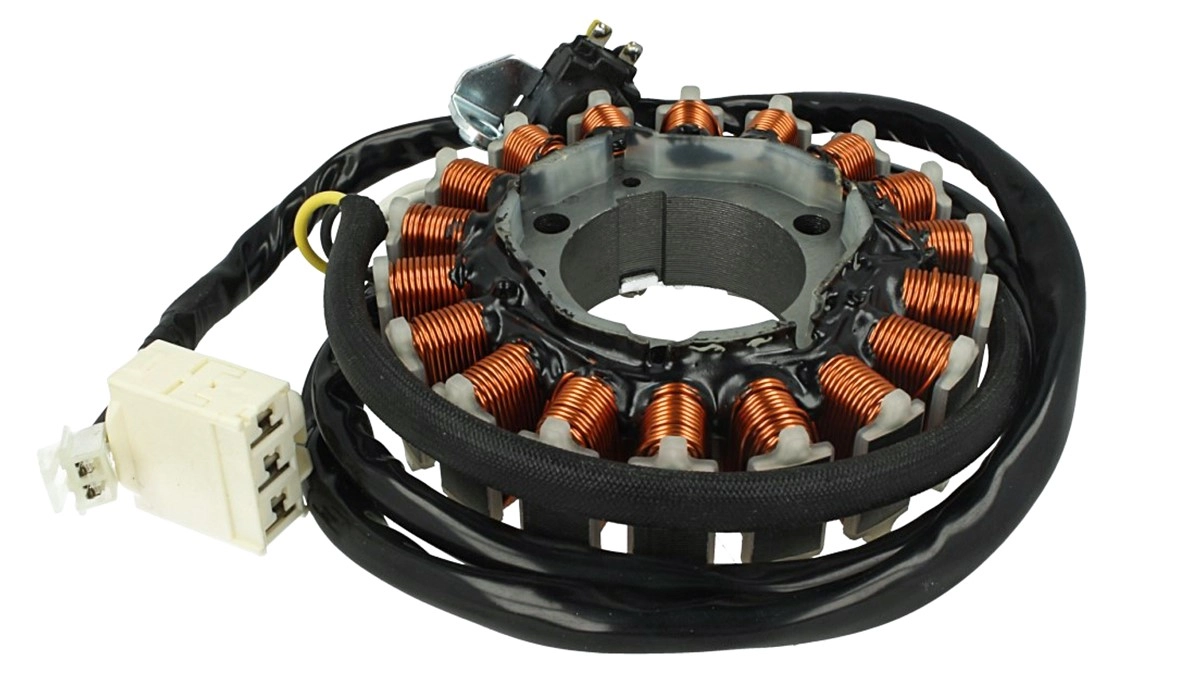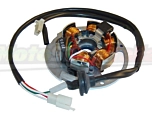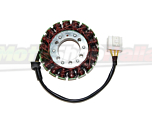"How much should I spend on a motorcycle stator?" is a question many of us bikers find ourselves asking. With all the options available, it can be hard to determine the right price for a stator. Let's dive into the heart of the matter and explore the world of motorcycle stators.
A stator is not just a piece of metal in the engine. It's the vital energy source for our bike. Without it, we're stuck. Like a clock without batteries. It's the secret to keeping our bike lively and ready for action.
In this article, we'll take you on a journey of discovery. What is a stator? Why is it so important? And, most importantly, how much should it cost? These are the questions we'll answer.
The price of a stator varies widely. It depends on the bike model, brand, and technical specifications. A stator for a sports bike may cost differently than one for a touring bike. Each bike has its unique needs.
We'll show you how to navigate these options. We'll give you tips for choosing the right stator without overspending. Whether you're a fan of long rides or speed, this information is crucial.
We won't just talk about prices. We'll explore quality and features. We'll help you understand what makes a stator good or not.
Knowing about stators means taking care of your bike. It means avoiding breakdowns and unexpected expenses.
Understanding the Stator: Function and Role in the Motorcycle
Let's delve into the workings of the stator. As we said, it's more than just a component. It's the motorcycle's energy producer. Like a small generator, it turns the engine's motion into electricity. This power runs the bike and recharges the battery.
Think of the stator as the heart of the electrical system. Without it, no lights, no start. Imagine turning the key and... total silence. No response. That's what happens without a functioning stator.
The stator is located near the engine's flywheel. As the engine turns, so does the flywheel. This movement creates electrical energy. It's a bit like pedaling a bicycle with a dynamo. The faster you go, the more light you generate.
But the stator is not just a generator. It's also a regulator. It keeps the current stable. It protects the bike from power surges. It's like having a faithful protector watching over the bike's electrical health.
For example, imagine a long day of riding. We use lights, the horn, GPS. All these consume power. The stator works to recharge the battery as we ride. It allows us to use all these devices without worries.
In case of a stator failure, the bike stops. Lights out, engine silent. It's a clear sign something is wrong. That's why understanding how it works is so important.
Factors Affecting the Cost of a Motorcycle Stator
When it comes to buying a motorcycle stator, the price can vary significantly. Several factors influence the cost. Among these, the quality of the material, the brand and model of the bike, and additional technologies and features play key roles.
Let's start with material quality. A stator made from high-quality materials lasts longer. A material resistant to high temperatures and wear ensures better performance. It's like comparing a Swiss watch to a market one. The difference shows over time.
Next, the brand and model of the bike. Not all stators are the same. A stator for a BMW, for instance, will cost differently than a stator for a Yamaha. Luxury or special bikes require specific stators. It's like choosing spare parts for a Ferrari versus a Fiat.
Technology and additional features affect the price. Some stators come with advanced functions. They might offer better voltage regulation or be more shock-resistant. It's like buying a phone: the more features it has, the more it costs.
Let's take a concrete example of factors affecting the cost of a motorcycle stator. A biker with a high-end bike might choose a stator with advanced specifications. This is because they want to maximize performance and longevity. In contrast, someone with a more economical bike might opt for a standard stator.
Another aspect is compatibility. Not all stators fit every bike. Choosing the right one is crucial.
So, the cost of a stator varies based on these factors. Quality, bike model, and additional technologies determine the final price. Choosing wisely means investing in your bike's longevity and efficiency. It's an important decision for every biker.
Price Range for Different Types of Stators
In the motorcycle stator market, prices can vary widely. This variation is influenced by factors such as the type of motorcycle, the brand of the stator, and its features.
For example, aftermarket stators, which are non-original, can have different prices compared to original stators. Aftermarket stators are often chosen for their value for money and can vary greatly in cost.
On our MotoShopItalia website, there are various prices for stators. For instance, a stator for Honda SH, Dylan 125/150 costs about €31.00. In contrast, a stator for Aprilia, Gilera, Malaguti, and Piaggio 125/150/180/200 is available for about €43.00. Another example is the stator for Aprilia Caponord 1200, priced at approximately €199.90.
These examples show how the price can change based on the brand and model of the motorcycle. Stators designed for specific models or high-end bikes tend to have higher prices. At the same time, for some more common motorcycles or older models, stators can be more affordable.
In general, when choosing a stator, it's important to consider the quality-price ratio. Cheaper stators might not offer the same durability or efficiency as higher-end ones. However, for many bikers, aftermarket stators represent a valid choice for their good quality-price ratio.
To select the right stator, it's essential to consider the type of motorcycle, specific needs, and available budget. The choice should be based on a balance between cost, quality, and compatibility with the motorcycle model.
When to Replace the Motorcycle Stator: Signs Not to Ignore
Recognizing the symptoms of a faulty stator is important to keep your motorcycle in top condition. One of the main symptoms of a faulty stator is the battery not charging. If you notice that the battery drains quickly or doesn't recharge while driving, it could be an indicator of a stator problem.
Another common symptom is the inability to start the engine. If the engine doesn't start or shows signs of difficulty during ignition, it could be due to a stator failure. This happens because the stator no longer produces enough current for the spark plug, which is essential for starting.
To verify if the stator is actually faulty, you can perform a test with a multimeter, measuring the output voltage from the motorcycle stator's wires. Normally, you should record a voltage of about 20 volts at idle and 70 volts at high revs for any pair of terminals. If the measurements you find are lower or you don't detect any voltage at all, it means there's a problem with the stator.
Regarding maintenance and fault prevention, it's always important to perform regular checks. You should ensure there are no damaged or loose wires and that connections are clean and free from corrosion. It's also useful to avoid exposing the motorcycle to extreme conditions that could cause excessive vibrations, as they can damage the stator.
How to Choose the Right Stator for Your Motorcycle
Choosing the right stator for your motorcycle should not be overlooked. You need to consider various aspects, such as individual needs and the quality vs. cost ratio.
First, think about the type of motorcycle you have. Each motorcycle has different technical specifications. A stator suitable for a sports bike might not be the best for a touring motorcycle. For example, a stator for a Yamaha R1 will have different characteristics than one for a Honda CB500.
Then, evaluate the performance you desire. If you are a racing enthusiast or use the motorcycle under extreme conditions, you might need a high-quality stator. These stators guarantee optimal performance but come at a higher cost.
Cost is another important factor. Balance quality and price. Sometimes, it's worth spending more on a product that offers better performance and durability. In other cases, an economical stator may suffice, especially for less demanding everyday use.
Also, consider ease of installation. Some stators may require specific technical skills for installation. If you're not experienced in mechanics, you might need to consider installation costs by a professional.
Remember to check compatibility. A stator must be perfectly compatible with your motorcycle model. An error in this phase can lead to malfunctions and operational problems.
Finally, read reviews and feedback. Other bikers' experiences can provide valuable information about the quality and reliability of a particular stator.
The right stator choice depends on a combination of factors. Carefully assess your needs, the type of motorcycle you own, and your budget. A thoughtful choice will ensure optimal performance and extend the lifespan of your motorcycle.
Installation and Maintenance of the Stator: What You Need to Know
To properly install a stator, it's crucial to follow certain steps. First, ensure that the motorcycle is off and disconnect the old stator from the battery and electrical system. Then, remove the screws securing the stator and install the new stator, making sure it is well-attached. Connect the wires of the new stator to the electrical system and the motorcycle's battery.
During the stator replacement, it's essential to also check the voltage regulator. A faulty voltage regulator can damage the stator. To test the regulator, use a multimeter set to the DC voltage measurement mode. With the motorcycle on, measure the voltage at the regulator's terminals. If the voltage is between 13.8 and 14.5 volts, the regulator is functioning correctly.
For periodic maintenance of the stator, one of the most important tests is the continuity test. You can use a multimeter to check if there's continuity between the various wires of the stator. Generally, you should find very low resistance (a few ohms) between the wires. If one of the wires is broken, it might be necessary to replace the stator.
Another important aspect is monitoring the stator's output. To do this, you can connect a 12 V 21 W bulb (like those used for turn signals, but not LEDs) to the stator wires with the engine running. The bulb should light up brightly, indicating that the stator is functioning properly. If the bulb doesn't light up or if it lights up when connected to a wire and ground, then the stator might be faulty.
Remember, if you're not confident in your abilities or if you encounter complex problems, it's always better to consult a professional. These tips will help you keep your stator in good condition and ensure the proper functioning of your motorcycle.
Final Considerations and Recommendations
You've reached the end of this article on motorcycle stators. Here's a summary of the key points and some final recommendations to help you make the right choice:
-
Importance of the Stator: Remember that the stator is a vital component for the motorcycle's electrical system. Without it, your motorcycle cannot function properly.
-
Quality of Material: The quality of materials affects the durability and performance of the stator. A good stator may cost more, but it will offer greater reliability over time.
-
Compatibility with the Motorcycle: Ensure that the chosen stator is compatible with your motorcycle's model and brand. An unsuitable stator can cause problems and inefficiencies.
-
Quality-Price Ratio: Balance cost and quality. Sometimes, it's worth investing in a higher-quality stator to avoid future failures and greater expenses.
-
Maintenance and Installation: Do not neglect regular maintenance of the stator and carefully follow the installation instructions. If you're not confident, seek the intervention of a professional.
-
Reviews and Feedback: Before purchasing your preferred stator, consult reviews and feedback from bikers. These insights can offer you a real view of the quality and performance of the stator.
Now that you are informed on how to choose the right stator, we invite you to explore our selection of stators on our website. You'll find a variety of options suitable for different needs and budgets.

 Italiano
Italiano


